No products in the cart.
History
NASCAR, the National Association for Stock Car Auto Racing

Oval Tracks
Predominantly, oval tracks are the staple of NASCAR. These circuits, usually spanning 1-2 miles, can either be banked or flat. Banked ovals boast sloped edges that enable drivers to navigate turns at elevated speeds, whereas flat ovals demand more finesse and precision. Daytona International Speedway, a 2.5-mile banked oval, is the most iconic oval track in NASCAR, hosting the esteemed Daytona 500—the season-opening race in NASCAR’s premier Cup Series. Other renowned oval tracks include the Indianapolis Motor Speedway, Charlotte Motor Speedway, and Bristol Motor Speedway.
Road Courses
Featuring both left and right turns, road courses incorporate elevation changes, demanding a distinct skill set compared to oval tracks. Drivers must expertly maneuver complex turns and varied terrain. Sonoma Raceway in California, a 2.52-mile circuit with 12 turns, is one of the most famous road courses in NASCAR, acclaimed for its picturesque views of the Sonoma Valley. Watkins Glen International in New York, another popular road course, is celebrated for its high-velocity straightaways and challenging turns.
Short Tracks
Measuring less than a mile, short tracks require drivers to exhibit exceptional car control and precision, as they must negotiate tight turns and brief straightaways. Martinsville Speedway in Virginia, a half-mile track, is among the most renowned short tracks in NASCAR, notorious for its tight turns and short straightaways, often leading to bumping and rubbing between drivers. Other sought-after short tracks encompass Richmond Raceway, Bristol Motor Speedway, and New Hampshire Motor Speedway.
Superspeedways
Spanning over 2 miles, superspeedways permit drivers to achieve remarkably high speeds. Cars must possess specialized aerodynamic packages to minimize drag and enhance velocity. The most distinguished superspeedway in NASCAR is Talladega Superspeedway in Alabama. Renowned for its high-banked turns and high-speed drafting, the 2.66-mile track allows drivers to form packs to increase speed and momentum. Other sought-after superspeedways include Daytona International Speedway, Michigan International Speedway, and Indianapolis Motor Speedway.
Dirt Tracks
In 2021, NASCAR ushered in a new era by incorporating dirt tracks into its Cup Series, debuting at the renowned Bristol Motor Speedway. Distinct from asphalt circuits, these dirt tracks necessitate specialized tires and suspensions for cars to conquer the treacherous terrain. During a dirt track race, the surface conditions can shift dramatically, notorious for their capricious nature. A handful of dirt tracks in NASCAR have risen in popularity, such as Bristol Motor Speedway, Eldora Speedway, and Knoxville Raceway.
Consequently, NASCAR boasts an array of tracks, each presenting its own unique challenges and attributes. From the high-octane thrill of superspeedways to the technical mastery of road courses, NASCAR caters to the passions of all racing aficionados. Whether you’re a die-hard devotee or a novice spectator, observing these skillful drivers navigate these tracks is guaranteed to send your heart racing.



